|
Report
from
Europe
EU tropical wood imports decline 13% in 2013
The EU imported tropical wood products with a total value
of €1.91 b illion in 2013, 12.6% less than the previous
year.
Between 2012 and 2013, import value declined across all
product groups including:
sawn wood (down 13.2% to €633 million),
joinery products (down 8.8% to €208 million),
plywood (down 5.6% to €206 million),
mould ings and decking (down 26.4% to €177 million),
veneers (down 4.9% to €168 million),
flooring (down 21.7% to €88 million),
logs (down 15.6% to €83 million)
and
other products (down 8.8% to €347 million).
EU tropical wood import value last year was around 50%
of the peak achieved in 2007 and is the lowest recorded in
recent years (Chart 1).
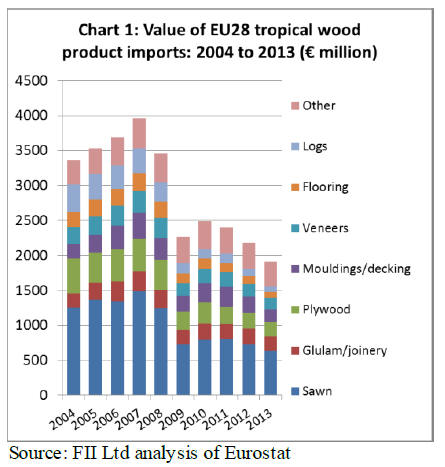
Closer analysis of monthly data indicates that EU tropical
wood imports hit a low of €150 million in December 2012
and then staged a brief recovery over the spring and
summer period to reach a high of €169 million in May
2013 (Chart 2).
However, monthly imports fe ll back again to only €148
million in December 2013 when there was a particularly
sharp downturn in sawn hardwood imports. The fall in EU
imports of tropical wood products in 2013 was part of a
wider trend of declining imports across nearly all forest
product groups, including sawn softwood, temperate
hardwood products, wood furniture and pulp and paper.
This is explained by the combined effects of recession in
Europe, supply diversion to other more active global
markets, and rising share of domestic production in EU
consumption.
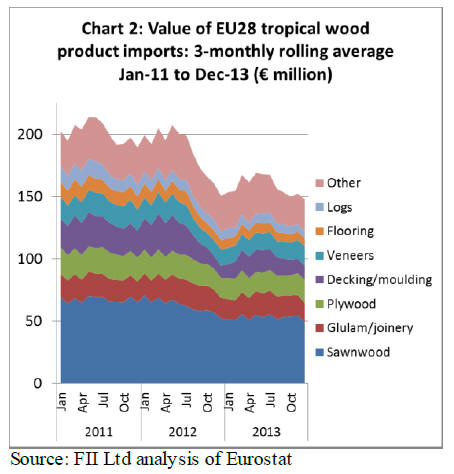
EU construction rises slightly but remains 20% below
pre-crises levels
A variety of indicators show that March 2013 was the
point at which economic activity across Europe was at its
lowest ebb at the end of a long cold winter. This is
particularly true of the construction sector, such an
important driver of timber demand in Europe.
Total construction value across the EU in March 2013 was
23% less than in early 2007 just prior to the financial
crises. In the months following March 2013, EU
construction activity increased marginally to around 20%
below the pre-crises level.
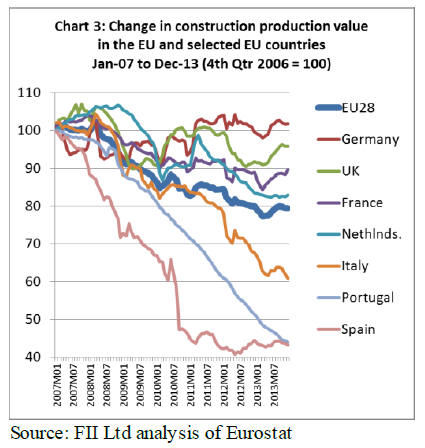
Chart 3 reveals how the t iming and depth of construction
industry recession and recovery have varied widely
between countries. Construction activity in Germany, the
UK and France has been relatively resilient over the last 5
years and was showing signs of revival in the second half
of 2013.
This is in contrast to Spain, Portugal and Italy where the
value of construction is well down on pre-recession levels
and has yet to show any signs of recovery.
EU tropical log imports fall another 20%
EU imports of tropical hardwood logs were 186,000 m3 in
2013, down 20% compared to the previous year. Imports
of this commodity into France, the main destination, were
down 20% at 86,350 cu.m.
Imports from all the leading supply countries declined,
including Congo (Kinshasa), Congo (Brazzaville),
Cameroon, Central African Republic, and Liberia (Chart
4).
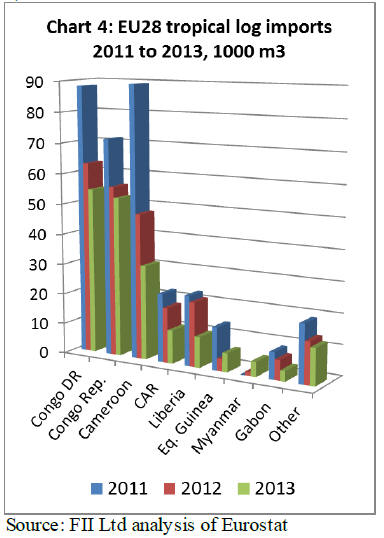
The decline is due to the combined effects of weak
European demand, supply constraints, and regulatory
uncertainty. The European okoume plywood
manufacturing sector, formerly a major buyer of logs, has
struggled to compete during the recession and capacity is
now small, with a significant share of production having
relocated to Gabon.
Due to supply problems and rising log prices, more central
European mills that formerly imported tropical hardwood
logs for sawing and slicing have switched to temperate
hardwoods this year.
On the supply side, polit ical unrest restricted log
availability from Central African Republic in 2013. The
Liberian government placed a freeze on all logging
activities in January 2013, including on the exportation of
logs from the country.
Meanwhile, encouraged by the EUTR, environmental
groups have focused heavily on finding discrepancies in
the legal documentation for log exports from the Congo
basin. This has added to the already high level of
uncertainty in the EU tropical hardwood log trade.
The only significant upward t rend in EU tropical log
imports was of teak from Myanmar. This has followed the
end of trade sanctions and has also been encouraged by
Myanmarí«s announcement of a ban on log e xports fro m
April 2014. The main European end users in the boat -
building sector have been building stocks in advance of
the measure.
EU sawn tropical hardwood imports down another 8%
EU28 imports of tropical sawn hardwood in 2013 were
930,000 m3, 8% down on the previous year (Chart 5).
Declining imports from Cameroon, Malaysia, Brazil, Ivory
Coast, Ghana and Indonesia were only partly offset by
rising imports from Gabon and the Congo countries.
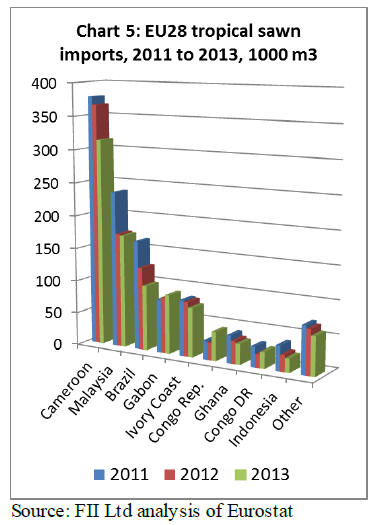
Imports of sawn tropical hardwood declined into Belgium,
Netherlands, Italy, UK, Spain, and Portugal. However
there was a 4% increase in imports into France and
imports into Germany remained level (Chart 6).
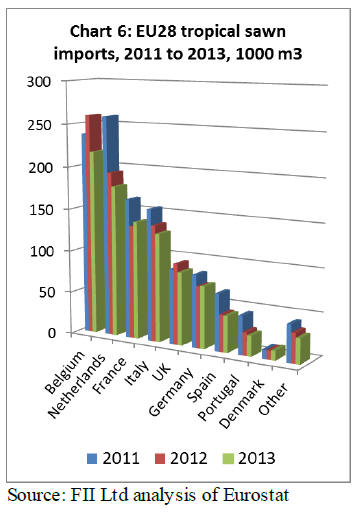
EU imported 314,000 m3 of sawn hardwood from
Cameroon in 2013, 14% less than the previous year. This
was partly due to mounting supply problems in Cameroon
which have been particularly pronounced for sapele, the
most popular commercial species in Europe.
By the end of 2013, lead times for delivery into Europe of
new orders of sapele from Cameroon were around 6
months. This resulted in sharply rising prices both on an
FOB basis and for landed stock in the EU.
EU imports of sawn wood from Cameroon were low in the
first half of 2013 before recovering slightly in the third
quarter. However they fell back sharply in December
2013, a short trading month when there was also a strike at
Came rooní«s ma in port of e xport in Douala.
Gabon was the second largest African supplier of tropical
sawn wood into Europe in 2013, supplying 89,000 m3
during the year, a gain of 6% compared to 2012. In the
early months of 2013, EU imports of sawn hardwood from
Gabon were affected by the economic slowdown in
France, the main market, and by harvesting restrictions
which led to reduced log supply in the country.
However, both problems eased during the course of 2013
which led to a strengthening recovery in EU imports from
the country.
Some of the large European owned operations in Gabon
which have made a strong commitment to delivery of
certified wood products may also now be benefitting from
the introduction of EUTR in March 2013.
This might also partly explain the 65% increase in EU
imports of sawn hardwood from the Congo Republic to
44,000 m3 in 2013.
EU imports of tropical hardwood from Cote dí«Ivoire fe ll
10% to 75,000 m3 in 2013. Most of this decline occurred
in the early months of the year when EU importers were
concerned about possible EUTR conformance issues.
However, EU imports from the country recovered in the
second half of 2013 as traders grew more confident that
the available legal documentation would stand up to
EUTR scrutiny. EU imports from Ivory Coast also
benefitted from slow recovery in demand for key species
like framire and ayous in the UK and Italian markets
during the second half of 2013.
EU imported 172,000 m3 of sawn hardwood from
Malaysia in 2013, 1% less than the previous year. Imports
from Malaysia were particularly weak in the first half of
2013, due to very slow activity in the northern European
construction market.
Orders picked up towards the end of the year, part ly in
response to improved demand, part icularly in the German
and UK construction sectors, together with restocking in
advance of the increase in EU import duties on Malaysian
products from 3.5% to 7% on 1 January 2014 due to a
change in Malaysiaí«s GSP status.
EU sawn hardwood imports from Brazil fell 21% to
99,000 m3 in 2013, continuing the sharp downward trend
which set in at the start of the European recession.
The decline from Brazil is due to the combined effects of
weak EU demand, exchange rate volatility and rising
prices in response to improved US demand and more
restricted supply as the Brazilian government has taken
steps to curtail illegal logging.
The problems of obtaining legality assurance in the
complex fragmented supply chains that exist in the
Brazilian Amazon may be another contributing factor
since implementation of EUTR.
Downward trend continues in EU decking and
mouldings imports
EU imports of ĘDcontinuously shapedíČ wood (HS code
4409) from tropical countries fell 19% in 2013 to 178,000
m3 (Chart 7).
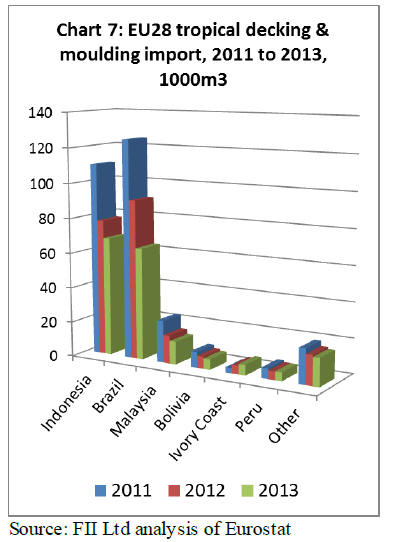
Imports from Brazil fell part icularly heavily, down 30% to
64,000 m3. Imports also fell from Indonesia (-13% to
68,000 m3), Malaysia (-19% to 13,000 m3).
Continuously shaped wood products listed under HS4409
include both decking products and interior decorative
products like moulded skirting and beading. The market
for tropical hardwood decking timbers in Europe during
2013 was very slow.
Imports were impacted by a stock overhang after low
levels of consumption in 2012. As prices for Asian
bangkirai declined in 2013, Amazonian species like garapa
and massaranduba became less competitive so that imports
from Brazil fell part icularly heavily.
Tropical hardwood also suffered a further loss of share in
the decking sector both to other wood species and to
Wood Plastic Composites.
EU imports of tropical mouldings for interior applications
were also declining in 2013 due to falling competitiveness
relative to EU domestic production.
For e xamp le, Bra zilí«s hardwood industry continues to
suffer from high and rising labour and other business
costs. Hardwood decorative mouldings of all types are also
coming under intense competitive pressure from pine and
MDF.
However there were isolated reports in 2013 of some
tropical interior mouldings products regaining market
share at the expense of temperate hardwoods. For
example, in recent years American tulipwood made
significant inroads into the European market for painted
mouldings.
In 2013 Ghanaian wawa was retaking share as the price of
American tulipwood increased. During 2013, lack of log
supply and rising US and international demand led to a
significant increase in prices across the full range of
American hardwood species.
Falling EU imports of engineered wood window
scantlings from the tropics
Weak construction sector activity during 2013 led to
further declines in EU glulam imports (Chart 8). EU
imports of this product, which consist primarily of
scantlings for the window sector, were 56,000 m3 in 2013,
12% less than the previous year.
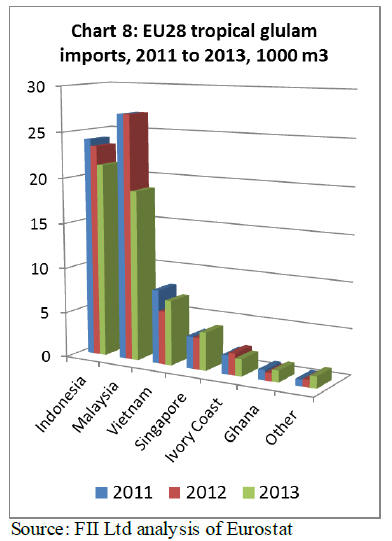
EU imported 19,000 m3 of scantlings from Malaysia in
2013, 31% less than the previous year. Imports from
Indonesia declined 9% to 21,000 m3 in 2013. However,
there was a slight increase in EU imports of glulam
products from some smaller suppliers, including Vietnam,
Singapore and Ghana.
Short-term prospects for meranti window scantling in the
EU market remain poor. Despite limited imports in 2013,
importersí« inventories are still quite high relat ive to slow
demand.
However longer term prospects appear more promising.
More building permits are now being issued in Germany,
the leading European market, and there is rising
confidence in the German construction sector.
The UK construction sector is also rebounding more
strongly than expected this year. The UK has not been a
significant market for tropical hardwood glulam in the
past, but interest in engineered scantlings is now rising
with introduction of tougher quality and energy-efficiency
standards for wood windows.
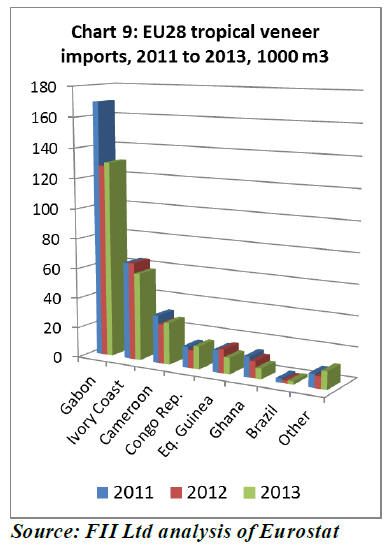
These factors, together with limited supply of sapele, the
leading African wood used in European joinery, might
lead to improving European demand for meranti window
scantlings during summer 2014.
Tropical hardwood veneer imports stabilise at a low
level
After significant falls in previous years, EU imports of
tropical hardwood veneers stabilised at a low level in 2013
(Chart 9).
Imports were 263,000 m3, 1% down compared to the
previous year. Imports from Gabon - which fell heavily
between 2011 and 2012 - increased 2% to 130,000 m3 in
2013. Imports also increased 5% from Cameroon and 29%
from the Congo Republic in 2013.
However imports from Ivory Coast fell 10% and imports
from Equatorial Guinea were down 31%.
The EU market for hardwood veneers remains very
difficult, with producers suffering from declining turnover
in the face of lower sales volumes, declining prices and
continuing loss of market share to competitors.
Prices continue to be under pressure for mass -production
grades for the plywood, flooring and furniture, and this
pressure also now extends into the market for more
specialist grades. Demand and prices are not expected to
recover significantly in 2014.
ETTF reports only limited impact of EUTR so far
While ití«s possible that some of the recent downturn in EU
imports of tropical wood was due to legal uncertainty
following implementation of the EUTR, other economic
and commercial factors were probably much more
significant drivers of trade during 2013. According to a
recent analysis of the trade impact of EUTR by the
European Timber Trade Federation:
ĘDlonger term trends are obscured by the overwhelming
effect of the economic downturn and by supply problems
due to capacity closures and diversion of wood fibre to
other markets over recent yearsíČ.
Furthermore, while EUTR has been enforceable since
March 2013 in theory, it is still very early days in practice.
This is clear from the recent survey of EUTR authorit ies in
EUWID. The German trade journal reports that Competent
Authorities are already active in Denmark, UK, Germany,
and the Netherlands.
However the pace of implementation has been slower in
France and southern and eastern Europe. The EC process
to formally recognise Monitoring Organisations is also
taking time, with only two so far appointed - Conlegno in
Italy and Nepcon with EU-wide coverage.
Even in countries where Competent Authorities are act ive,
building up the necessary capacity and knowledge
required to provide advice and pursue successful
prosecutions remains a challenge.
The real impact of EUTR will only become clearer as the
EU economic recovery gathers pace and as more progress
is made to develop enforcement capacity and impose
sanctions.
|